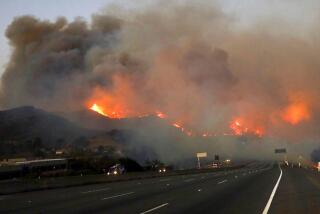Budget Hearings End; Special Units Funded
County supervisors parceled out more than $45 million for fire departments, libraries and other special districts Tuesday, ending public hearings on the $1.45-billion budget for the 1985-86 fiscal year.
The Orange County Fire Department received $20.1 million from the special district augmentation fund; the county library district got $4.8 million, and the county flood control district received $19.9 million, which was $540,311 more than it requested.
The supervisors will formally adopt the budget on Aug. 27. Tuesday’s hearing, the third in a series that began last Wednesday, lasted less than an hour and went smoothly.
No Funds for Units
For the second year, no money from the augmentation fund was disbursed to the administrative and geographic units--known as county service areas and located in unincorporated county territory.
The lack of appropriations was in keeping with the policy vote of the supervisors several years ago to get the service areas--which include communities such as Laguna Niguel and Rossmoor--to levy user fees on their residents, rather than depend on property taxes collected from throughout the county.
The supervisors do not want money collected from the entire county to finance services for residents of a limited geographic area. They said they wanted the augmentation funds to go for services that benefited the whole county, such as fire protection and libraries.
County service areas originally financed their budgets through property tax collections. But after Proposition 13 in 1978 slashed the property tax, the service areas--and some other special districts--lacked funds.
To help bridge the gap, the state Legislature set up the special district augmentation fund, which got its money from property taxes.
Cites Private Guards
Bob Hamilton of the county Environmental Management Agency said that in some cases “it was recognized that the principal service and cost of (county service areas) was security gate guards to keep the public out of their private communities. And it was felt inappropriate to allocate to them property taxes that had been collected countywide in order to pay for a service that keeps the pubic from entering their community.”
As a result, supervisors warned the service areas several years ago that they would eventually be cut off from augmentation funds and would have to impose user fees on residents in their areas to pay for continued services such as street sweeping, grass cutting and trash pickups.
Supervisors have also been encouraging the community service areas to become community service districts, giving them more control over what occurs within their borders and reducing the cost to the county.
More to Read
Sign up for Essential California
The most important California stories and recommendations in your inbox every morning.
You may occasionally receive promotional content from the Los Angeles Times.










